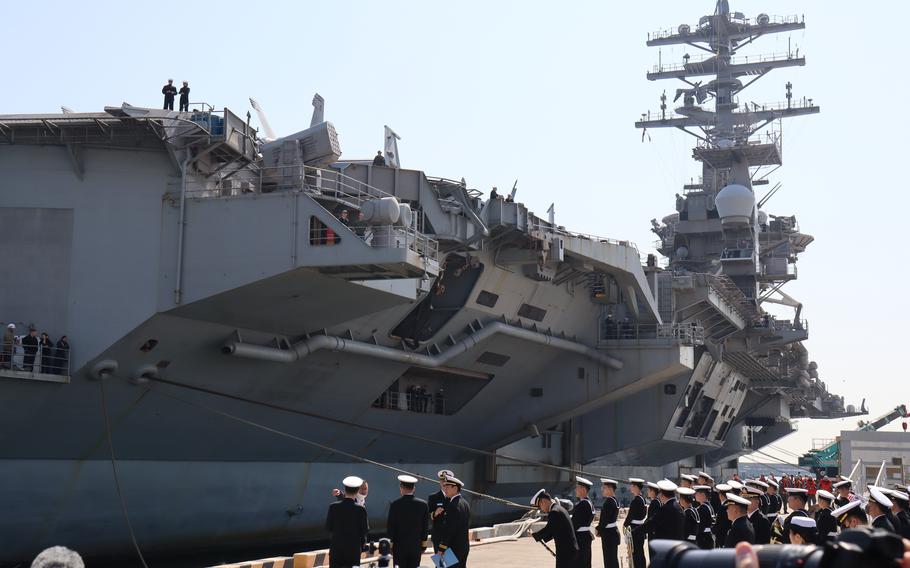
The aircraft carrier USS Nimitz arrives to a welcome ceremony at Busan, South Korea, March 28, 2023. (David Choi/Stars and Stripes)
BUSAN, South Korea — A Navy carrier strike group steamed into South Korea’s largest port Tuesday for a joint exercise a day after North Korea fired two ballistic missiles.
Roughly 7,000 U.S. sailors and Marines from Carrier Strike Group 11 and its flagship, the nuclear-powered aircraft carrier USS Nimitz, docked at Busan for an ongoing, large-scale drill by U.S. and South Korean naval forces.
The two-week Ssangyong Exercise in and around the Korean Peninsula is the largest U.S.-South Korean maritime drill in five years. Over 30 ships and 70 aircraft, and roughly 50 amphibious assault vessels, are scheduled to participate in the exercise until Monday, according to South Korea’s Ministry of National Defense.
The scheduled exercise is taking place in international waters in a “professionally safe” manner, the strike group commander, Rear Adm. Christopher Sweeney, told reporters on the Nimitz flight deck.
Two weeks ago, spokesman Wang Wenbin of China’s Foreign Affairs Ministry said Beijing was “gravely concerned” about the exercise.
“The current situation on the Korean Peninsula is highly complex and sensitive,” Wang said at a March 14 news conference in Beijing. “All parties concerned should remain restrained and do more things that are conducive to peace and stability on the Korean Peninsula, not otherwise.”
Tensions on the peninsula are at a “critical point,” North Korea’s state-run newspaper Rodong Sinmun said Tuesday. It said the U.S. is “undisguised in their attempt of aggression” against North Korea.
“All the demonstrative military exercises of the enemy clearly show that they are military actions of preemptive attack, which can no longer be overlooked as they are conducted …,” Rodong Sinmun reported.
North Korea launched two short-range ballistic missiles Monday, its eighth day of testing this year.
The U.S. does “not seek to contain China” nor a conflict with North Korea, but is “not going to be bullied,” Sweeney said.
“We are not going to be coerced and we are going to stay here, fly and operate under international norms to [assure] all our allies and partners,” Sweeney said. “We’re not going anywhere.”
The Nimitz’s arrival in Busan, its first in 10 years, comes six months after a visit by the aircraft carrier USS Ronald Reagan.
Two days before arriving, the Nimitz and destroyers USS Wayne E. Meyer and USS Decatur conducted anti-submarine and air defense drills with the Japan Maritime Self-Defense Force, according to a Navy news release.
On Monday, the Nimitz, Meyer and Decatur joined two South Korean destroyers off the southern South Korean island of Jeju, according to a Ministry of National Defense news release.
Large-scale joint drills like Ssangyong by U.S. and South Korean forces returned this year after a long absence on the Korean Peninsula.
Earlier this month, soldiers from South Korea and the U.S. 2nd Infantry Division held their largest Warrior Shield field exercise in six years, while U.S. Forces Korea and the U.N. Command conducted the tabletop Freedom Shield exercise.
The U.S. may deploy more of its military assets to Seoul in the future, South Korean Defense Minister Lee Jong-sup said Jan. 1 during a meeting with U.S. Defense Secretary Lloyd Austin.
The two defense chiefs “agreed to closely consult for timely and coordinated deployment of strategic U.S. assets,” Lee said.
“You can look for more of that kind of activity going forward,” Austin said. “But in addition to that, you can look to see deeper consultation between our two countries and that leadership.”